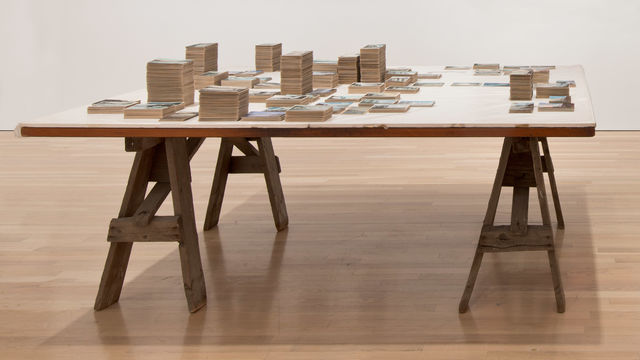
Zoe Leonard
"Confrontational and demanding . . . without ever letting go of their own sense of beauty" is how Zoe Leonard describes the artists who have inspired her.# The same can be said of her own work. Indeed, Leonard's serial photographs act as nuanced, challenging, and frequently moving meditations. Invoking themes ranging from loss, mourning, and decay to gender, difference, and desire, her works upend the notion that a photograph—or any image—offers an absolute or authoritative truth. In Leonard's treatment, multiple discrete depictions coalesce to offer deep insight into the structures and systems of our world and into the beings and objects that populate it.
Looking is central to Leonard's Survey (2012), in which more than six thousand vintage postcards depicting Niagara Falls are positioned in uneven stacks on a simple wooden worktable. From afar the work looks more like an architectural model of a cityscape than a collection of individual postcards. Seen at close range, the postcards align to create a kind of map of the falls. Survey is related to her earlier installation You see I am here after all (2008), for which the artist also collected thousands of postcards of the same subject and then arranged them on the wall according to vantage point, giving viewers the sense that they are moving "around" the falls.# By anticipating a viewing subject in these works, Leonard reminds us that postcards not only represent a site but also are intended to be received by a person—indeed, they are as much an index of presence ("I am here!" a note on one of the postcards reads) as a marker of absence or of distance between sender and recipient. The postcards ultimately serve as a dual stand-in—a prosthetic and an index—representative of both geographic site and absent subject. Leonard's project, to line up contiguous or nearly contiguous depictions of Niagara Falls, forges a connection between the sometimes surprisingly disparate images, thereby mirroring the postcard's task of presenting iconic images of place but also commenting more broadly on the ever-changing role of photography in our culture.

Natural history museums are also the subject of Leonard's Trophies series (1990), comprising black-and-white photographs of a display of taxidermic animal busts. In the wider shots, ornate and diverse morphology is emphasized: curving horns, long necks, patterned shiny fur. In the tighter shots, distinct, unexpectedly expressive faces come into view. With mouths stretched, teeth gleaming, and eyes open wide, many of these animals appear frozen in agony. A few others, staring out solemnly, look more serene. In every case, it is as if the slaughtered animals are gazing directly into the camera, their faces conjuring an illusion of vivacity or sentience that is hard to shake. Leonard's Trophies bring to mind the philosopher Emmanuel Levinas's concept of ethics, which he founded on face-to-face encounters. It is through direct contact with another face, he argued, that humans are able to grapple most deeply with the subjectivity and dignity of the other—its immense vulnerability, irreducible singularity, and resemblance to all other faces. Levinas accorded faces the power to trigger a sense of interrelation, indebtedness, and responsibility. In his words, "The face opens the primordial discourse whose first word is obligation."# In Leonard's work, souvenir postcards and natural history museum displays are not carriers of objective, factual information but rather sites of singular subjectivities, empathy, accountability, and a kind of yearning—for connection, for recognition, and for that which is absent or beyond reach. Over time, just as Levinas asserted, a subtle but powerful ethical relationship takes shape.
—Leora Morinis


